 “Literature is picture-thinking, ideas made flesh in figures of speech”, wrote a former college professor and friend, Dr. Colin Campbell (from talk given 10/10/15).
“Literature is picture-thinking, ideas made flesh in figures of speech”, wrote a former college professor and friend, Dr. Colin Campbell (from talk given 10/10/15).
The author of 1st Peter creates such word pictures for us in spades. Chapter 2 is a rich example as the writer employs a stone metaphor to explain three different functions for Christ.
But I’m getting ahead of myself. When we come to a passage that seems to so obviously cluster ideas into a single image, it’s a great time to pause and ask the simple question, ‘why’.
Having recently visited Israel and one of the country’s richest archaeological sites, Bet She’an (ancient Scythopholis), I was struck by the enormous building project in the early 1st century the archaeologists are finding. Located just 23 miles from Nazareth where Jesus spent his boyhood, it’s easy to imagine that Jesus might have had some familiarity with it. As the capital of the Decapolis cities, this area included in the region called ‘Syria’, was one of many places where word of Jesus’ healing work spread. So his fame spread throughout all Syria, and they brought to him all the sick…(Matt. 4:24).
Back to those stones. The Romans were nothing if not builders. Cornerstones and keystones would have been part of everyday life, with people walking under a keystone, for instance, each time they went into an agora or marketplace — such as the center stone of the arch in the photo (from Bet She’an).
With building materials for houses made from mud-brick, the Romans would differentiate their architectural claim for imperial solidity and permanence with stone instead. Yet it wouldn’t be a leap of the imagination to see how an evangelist would declare that Christ is the only true stability, perhaps providing the basis of I Peter’s metaphor of stones.
The first reference using stones (in I Pet. 2:6) declares Christ is the cornerstone, the critical feature of a building on which everything else rests. Paraphrasing Isa. 28:16, the author explains that without Christ, there is no building. What a reminder that we build our faith on the spiritual facts that Jesus’ life so astoundingly illustrated.
The second stone reference comes immediately in I Pet. 2:7, only this time the author quotes Ps. 118:22, telling how this stone might have been initially rejected but it has since transformed into the cornerstone –a not very subtle reference to the way the Jews rejected Jesus as the Messiah yet so many others now build their lives on Christ Jesus’ teachings, including Gentiles.
The third and final reference is based on another quote from Isaiah, this time Isa. 8:14. Here Christ is the stone on which the disobedient stub their toes or stumble altogether for their lack of obedience.
These passages deserve greater thought and contemplation than this blog can provide, but we hope it teases you into seeing how rich Biblical language is to this amazing epistle of I Peter. Dig in and enjoy!




Thank you Madelon for your insights. I was thinking of that last reference as not only referring to the Jews rejection of Jesus as the Messiah but also to times when the pressures of time, family, or work may cause me to reject putting Jesus example and teaching first in my life. The result is that I kick the stones and trip up— everything tends to go wrong. That usually causes me to reasses my priorities and go back to what has worked time and time again, putting God first in my life through the example that Jesus set. Jesus… Read more »
Hi Madelon – thank you for your comments about “stones” in relation to Christ in I Peter. It made me stop and think about our use of the word stone in images today e.g. lively stones, millstones, grindstone, stones used for sharpening tools, even the saying: “a rolling stone gathers no moss”. Of course, “foundation stone” has a wonderfully strong sense of something basic, reliable, worthy of further building, safe, solid, but I’d never before thought about “keystone”. Your picture is so helpful. I love how the New Testament writers knew Scripture so well and quoted it all the time!… Read more »
Hi, Maddie, We were sorry that we couldn’t attend the Bible talks that you gave at ACR but we had a couple of grandkids that need to be cared for. Hugh and I were trying to think of the Bible translation that you used most. We have a number, but I didn’t think that we had the one that you use. We are looking forward to November. Please let us know when you have a moment. Thanks for all you are doing. Love, Sue